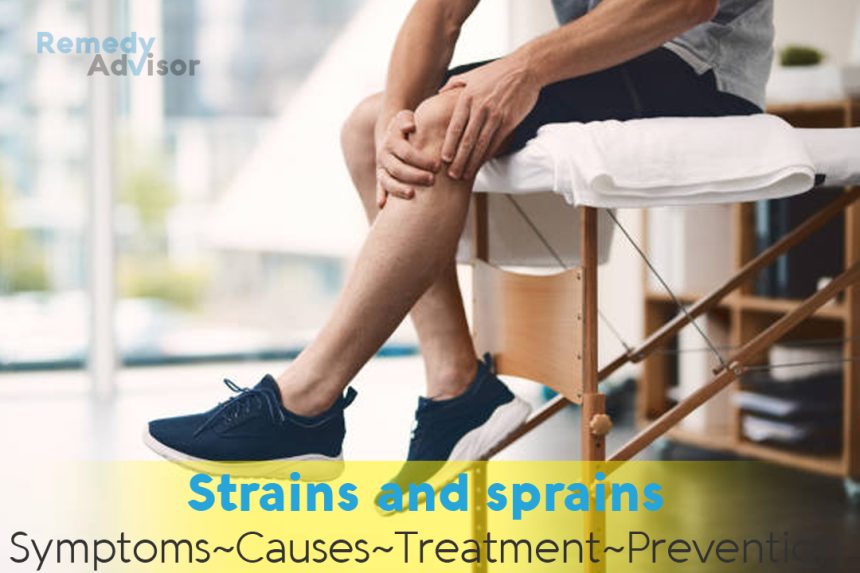What is it
These are the most common types of acute injury that is, an injury that usually results from a single, abrupt incident causing sharp pain, often accompanied by swelling. Strains and sprains are especially common among eager weekend athletes who don’t know the limitations of their unconditioned muscles and joints.
Strains
When a muscle is overstretched, some of its fibers may tear This is often called a pulled muscle. Mild strains are commonly only an irritation; the tears are microscopic and, with rest, repair themselves effortlessly. More severe strains involve a bigger amount of fiber destruction and produce severe pain with loss of movement and power.
Sprains
While strains occur to muscles, sprains damage ligaments (the bands connecting bones) and joint capsules. Just like strains, sprains can range from minor tears to whole breaks. But sprains tend to be more severe than strains: not only do they frequently take extended time to cure, but a torn ligament can throw bones out of alignment, causing damage to surrounding tissues.
Any joint can be sprained, but because of its construction and the fact that it must support your body weight, the ankle is the most frequently sprained joint in fact, an ankle sprain is probably the most common sports injury. The knee, too, is vulnerable because it must absorb twisting stress every time the body rotates from the hips.
Symptoms
Strain
- Muscle stiffness, soreness, and generalized tenderness several hours after the injury.
- Swelling of the injured muscle.
- In Some cases, skin discoloration appearing several days later.
Sprain
- Mild to severe pain when the injury occurs.
- Joint tenderness and possible swelling.
- Bruising that can be noted immediately or up to several hours after the injury.
- Inability or difficulty moving the injured joint.
What causes it
Strains occur when muscles or their tendons are stretched to the point their fibers actually start to tear. This can happen when you lift a heavy weight or suddenly overextend a muscle for instance, when swinging a golf club, sprinting to catch a bus, or stretching to catch a Frisbee. The most common sites for strains are the hamstring and quadriceps muscles in the thigh and the muscles in the groin and shoulder all large muscles that are used for sudden powerful movements. Strains also occur to a muscle that has been previously injured even slightly and never properly rehabilitated. Cold, fatigue, or immobilization in a cast reduces blood flow to the muscles and lessens muscle elasticity, increasing the risk of strains.
Sprains are most often the result of a sudden force, typically a twisting motion, that the surrounding muscles aren’t strong enough to control. As a result the ligaments, which usually wrap around a joint, get stretched and torn.
What if you do nothing
In most cases recovery from a minor muscle strain requires nothing more than rest. However, if you are active and exercise regularly, strengthening and stretching will usually be necessary after recovery to prevent a recurrence of the injury. Sprains usually require attention to reduce swelling and lessen pain. When severe pain or swelling occurs, you need to consult a doctor; the injury may turn out to be a severe sprain or a fracture, either of which require medical attention and possibly a splint or cast.
Home remedies
Minor sprains or mild to moderate muscle strains can usually be self-treated at home with these measures.
RICE the injured area
The acronym RICE rest, ice, compression, and elevation is the key to treatment. These steps reduce swelling, slow internal bleeding, and reduce pain.
With most injuries, swelling starts immediately; to reduce it, apply ice right away to the injured area. Wrap an elastic bandage snugly over the ice and around the injured site. Leave ice and bandage in place for 20 minutes, then remove the ice, rewrap the injury and elevate the injured part above the heart to help drain excessive fluid from the damaged part.
Depending on the severity of your injury, continue with the ice therapy every two hours for up to 24 hours. At that point, you can begin heat treatments (heating pad, compress, shower, or bath) to increase circulation and accelerate healing. If any swelling develops, stop the heat and continue with the cold.
Take OTC pain relievers
Nonprescription NSAIDs (aspirin, ibuprofen, or naproxen) will alleviate minor pain symptoms, though they won’t promote healing.
Start gentle exercise
Once pain and swelling have stopped, you can begin gentle stretching exercises to restore flexibility. Gradually add strengthening exercises with light weights to strengthen muscles and connective tissues around the affected joint.
Prevention
Exercise regularly
Participate in regular, moderate exercise to keep your muscles and joints strong and flexible. Stretch your muscles before and after exercise. Strong muscles are also an injury safeguard. Include several weekly strength-training sessions focusing on your major muscle groups.
Warm up sufficiently
Warm up, then stretch all the muscles involved in your upcoming activity. Activities such as jogging in place or stationary cycling for 5 to 10 minutes increase blood flow and raise the temperature of large muscle groups. You can also warm up by slowly rehearsing the sport or exercise you’re about to perform. A light sweat usually indicates that you’ve warmed up sufficiently.
Consider taping or wrapping a weak joint
Good taping can add stability to an injured joint and make it less likely to be reinjured. (If the sprain is severe, consult your physician or a physical therapist.)







